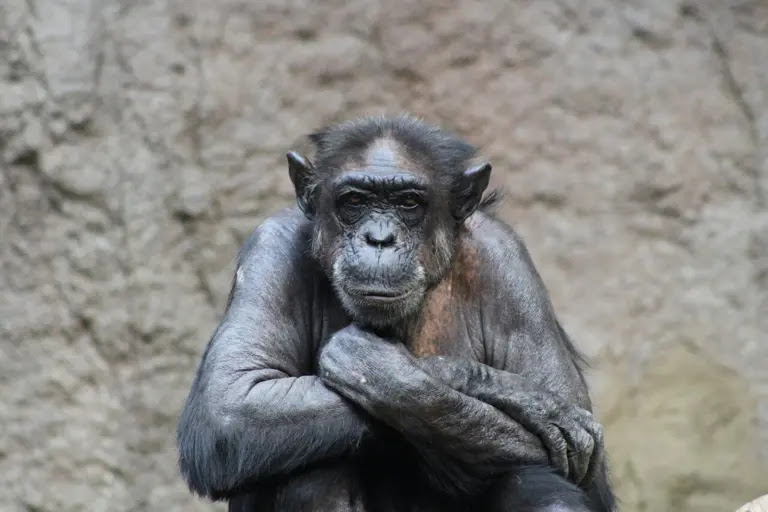
What makes the human brain unique? We compared it with monkeys and apes to find out
Story by Rogier Mars, Katherine Bryant
Scientists have long tried to understand the human brain by comparing it to other primates. Researchers are still trying to understand what makes our brain different from our closest relatives. Our recent study may have brought us one step closer by taking a new approach—comparing the way brains are internally connected.
The Victorian paleontologist Richard Owen incorrectly argued that the human brain was the only brain to contain a small area termed the Hippocampus minor. He claimed that made it unique in the animal kingdom and, he argued, the human brain was therefore clearly unrelated to other species. We’ve learned a lot since then about the organization and function of our brain, but there is still much to learn.
Most studies comparing the human brain to that of other species focus on size. This can be the size of the brain, size of the brain relative to the body, or the size of parts of the brain to the rest of it. However, measures of size don’t tell us anything about the internal organization of the brain.
For instance, although the enormous brain of an elephant contains three times as many neurons as the human brain, these are predominantly located in the cerebellum, not in the neocortex that is commonly associated with human cognitive abilities.
Until recently, studying the brain’s internal organization was painstaking work. The advent of medical imaging techniques, however, has opened up new possibilities to look inside the brains of animals quickly, in great detail, and without harming the animal.
We used publicly available MRI data of white matter, the fibers connecting parts of the brain’s cortex. Communication between brain cells runs along these fibers. This costs energy and the mammalian brain is therefore relatively sparsely connected, concentrating communications down a few central pathways.
The connections of each brain region tell us a lot about its functions.
The set of connections of any brain region is so specific that brain regions have a unique connectivity fingerprint. In our study, we compared these connectivity fingerprints across the human, chimpanzee, and macaque monkey brain. The chimpanzee is, together with the bonobo, our closest living relative.
The macaque monkey is the non-human primate best known to science. Comparing the human brain to both species meant we could not only assess which parts of our brain are unique to us, but also which parts are likely to be shared heritage with our non-human relatives.
 Related video: What If the Universe Is Conscious? (What If) – Search
Related video: What If the Universe Is Conscious? (What If) – Search
Much of the previous research on human brain uniqueness has focused on the prefrontal cortex, a group of areas at the front of our brain linked to complex thought and decision-making. We indeed found that aspects of the prefrontal cortex had a connectivity fingerprint in the human that we couldn’t find in the other animals, particularly when we compared the human to the macaque monkey.
But the main differences we found were not in the prefrontal cortex. They were in the temporal lobe, a large part of the cortex located approximately behind the ear. In the primate brain, this area is devoted to deep processing of information from our two main senses: vision and hearing. One of the most dramatic findings was in the middle part of the temporal cortex.
The feature driving this distinction was the arcuate fasciculus, a white matter tract connecting the frontal and temporal cortex and traditionally associated with processing language in humans. Most if not all primates have an arcuate fasciculus, but it is much larger in human brains.
However, we found that focusing solely on language may be too narrow. The brain areas that are connected via the arcuate fasciculus are also involved in other cognitive functions, such as integrating sensory information and processing complex social behavior.
Our study was the first to find the arcuate fasciculus is involved in these functions.
This insight underscores the complexity of human brain evolution, suggesting that our advanced cognitive abilities arose not from a single change, as scientists thought, but through several, interrelated changes in brain connectivity.
While the middle temporal arcuate fasciculus is a key player in language processing, we also found differences between the species in a region more at the back of the temporal cortex. This temporoparietal junction area is critical in processing information about others, such as understanding others’ beliefs and intentions, a cornerstone of human social interaction.
In humans, this brain area has much more extensive connections to other parts of the brain processing complex visual information, such as facial expressions and behavioral cues. This suggests that our brain is wired to handle more intricate social processing than those of our primate relatives.
Our brain is wired up to be social.
These findings challenge the idea of a single evolutionary event driving the emergence of human intelligence. Instead, our study suggests brain evolution happened in steps. Our findings suggest changes in frontal cortex organization occurred in apes, followed by changes in temporal cortex in the lineage leading to humans.
Richard Owen was right about one thing. Our brains are different from those of other species—to an extent. We have a primate brain, but it’s wired up to make us even more social than other primates, allowing us to communicate through spoken language.
More information: Katherine L. Bryant et al, Connectivity profile and function of uniquely human cortical areas, The Journal of Neuroscience (2025). DOI: 10.1523/JNEUROSCI.2017-24.2025
This article is republished from The Conversation under a Creative Commons license. Read the original article.
Provided by The Conversation
Felita LaRock sings God Bless America at Cincinnati Reds baseball opening day 2025!
Use this 1 mental hack to develop the personality trait that is key to living a long, happy life
76% fewer brain plaques: Aerobic exercise proves powerful weapon against Alzheimer’s
16 Simple Methods to Relieve Stress, Take Care of Yourself, and Ground Yourself
Stress Management Techniques to Take Years Off Your Age and Improve Health
4 ways to stop making life more difficult for yourself, from a Zen Buddhist monk
50 Mental Health Memes That Understand You Better Than Your Friends Do
The Neuroscience of Meditation: 10 Proven Effects on Brain Structure | Watch
The Science of ‘Deep Rest’—Why Doing Nothing Makes You More Productive
Why Most Productivity Hacks Fail (And How Mindfulness Fixes Them) | Watch
THE SOUND OF SILENCE – Simon & Garfunkel (Cover Benedetta Caretta)
Dementia study reveals how long people can expect to live after diagnosis
5 Tips for Women to Manage ADHD With or Without Medication | Watch
‘
Fast-Acting Brain Stimulation Offers New Hope for Severe Depression
The ‘Lazy’ Way to Meditate—And Why It Works Better Than You Think
I’m A Neuroscientist ― This Is My Brain-Boosting Morning Routine
20 Bible Verses About Stress to Help Calm and Relax Your Mind
The Dark Side of Mindfulness: Why It Can Hurt More Than Help
The Mindfulness Myth That’s Keeping You Stuck in Overthinking
Mindfulness is a Commodity Sold to Distract You from Chaos
Top 10 Meditation Techniques That Instantly Reduce Stress
12 Ways to Train Your Brain to Handle Stress Like a Pro
Mindfulness Is Not Self-Care—It’s Self-Mastery | Watch
The Mindfulness Trend is a Ruse for Escaping Reality
Brain Games: Natural Protection For an Aging Brain
13 drugs and supplements that could slow brain aging
Exercise of any kind boosts brain power at any age
.
MY NEWEST FAVORITE SONG
Dani and Lizzy – Dancing in the Sky – YouTube
Top 10 Meditation Techniques That Instantly Reduce Stress
Meditation for the Modern Mind: How to Find Stillness in a Chaotic World | Watch
The Brain Cells That Can Read People’s Minds ¦ Random Thursday | Watch
10-Minute Stress Relief: Simple Daily Exercises for a Calmer Mind | Watch
Mindfulness in the Age of Trump: Cultivating Calm Amidst Chaos | Watch
Gratitude 101: Simple Steps to Improve Your Mental Health Every Day
Scientists Are Finally Figuring Out How and Why We Dream | Watch
Overstimulated? How to Train Your Brain to Handle the Chaos | Watch
Mindfulness for Rebels: How to Stay Centered in a Divided World
Unplug and Recharge: Simple Strategies to Master Daily Stress
How to Find Peace in a Busy Life: Mindfulness for Beginners
What Really Happens to the Human Body in Space? | Watch
5 Simple Meditation and Prayer Practices and Their Benefits
How to Stay Mindful in a World Designed to Distract You
What daylight-saving time does to your body and brain
The mystery at the heart of consciousness | Watch
Mindfulness Hacks for Busy People
What if we live inside someone’s brain? | Documentary

